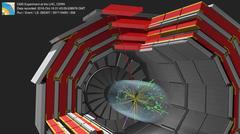URL: https://www.desy.de/news/news_search/index_eng.html
Breadcrumb Navigation
DESY News: W boson on the particle scale
News
News from the DESY research centre
W boson on the particle scale
Scientists need to know just how much mass the W boson has in order to check whether their theoretical predictions hold and spot deviations from them fast and reliably. The CMS experiment at CERN has now submitted the most precise measurement to date. In close collaboration, experimental and theoretical particle physicists at DESY played a major role in this challenging analysis.

CMS candidate collision event for a W boson decaying into a muon (red line) and a neutrino that escapes detection (pink arrow). (Image: CMS/CERN)
The result is the most precise measurement of the W mass taken so far at the LHC, and is in line with the prediction from the Standard Model of particle physics. The result was made possible due to a combination of experimental and theoretical factors including the most precise reconstruction of the muons in the CMS detector and a new theoretical approach conceived at DESY.
In the Standard Model of Particle Physics, the theory that describes all particles and the forces that act between them to the highest possible precision, the W mass is related closely to the strength of the interaction unifying the electromagnetic and weak forces, and to the masses of the Higgs boson and the top quark. Measuring the W boson mass with high precision therefore makes it possible to test whether or not these properties are consistent with the Standard Model. If they are not, the cause could be new physics phenomena such as new particles or interactions.
The W boson was discovered at CERN in 1983, but its mass has always been particularly challenging to measure. Since its discovery, several collider experiments at CERN and elsewhere have made ever more precise measurements of its mass. The CMS experiment has now contributed to this global endeavour with its first W boson mass measurement. The result, 80360.2 MeV with an uncertainty of 9.9 MeV, has a precision comparable to that of a measurement by the CDF experiment at Fermilab in the USA and is in line with all previous measurements except the CDF result.
“This analysis is the first attempt to measure the W mass in the harsh collision environment of the second running period of the LHC. And all the hard work from the team has resulted in an extremely precise W mass measurement and the most precise measurement at the LHC,” says CMS spokesperson Patricia McBride. “This is one of the most complex analyses I have ever seen in CMS,” adds DESY scientist Katerina Lipka, leader of the Helmholtz W2/W3 group “Standard Model at Ultimate Precision”. Simone Amoroso, and Federico Vazzoler, scientists in this group, were responsible for modelling the relation between the momentum of the W boson and the muon it decays to. For this, they worked closely together with the DESY theorist Frank Tackmann.
W bosons created at the LHC decay almost instantly into a muon and neutrino. Muons are detected by CMS, but the neutrinos cannot be seen by the detector, which makes this measurement so tricky. If both muons and neutrinos could be detected, the mass of the W boson would be measured directly from the energy and flight direction of the particles, as it is done for the Higgs boson, for instance. To tackle this challenge, researchers study the muon momentum, inferring the value of the W boson’s mass with very high accuracy.
The ultimate precision of the measurement relies on two factors: firstly, the CMS detector’s dedicated high-performance muon kinematics reconstruction algorithm. Knowing the kinematics of the muons that escape from decays of W bosons lets scientists draw conclusions on the kinematics of the W boson, which in turn tells them more about its mass.
Secondly, the teams used the latest and best understanding of the theoretical inputs and the experimental techniques. The standard way to tackle measuring the W mass was to use extremely precise measurements of the Z boson as a kind of control sample to precisely predict the kinematics of the W boson. Theorist Frank Tackmann and his ERC consolidator-grant team have developed a method that makes the CMS measurement (and potentially all future measurements as well) independent of the Z boson. “The problem had always been to precisely relate the Z to the W,” says Tackmann. The new method involves the simultaneous application of ten different theory parameters, giving robust and parametrised theoretical uncertainties that are key in correctly interpreting the data. “Running these state-of-the-art theoretical calculations and putting all the pieces together was quite a task!”, Simone Amoroso adds.
“This new CMS result that is in spot-on agreement with the Standard Model predictions is not just another proof of the robustness of the Standard Model,” Tackmann says. “It also increases our overall sensitivity for physics that may lie beyond it.”
More information: CERN press release and Backgrounder by the CMS collaboration



